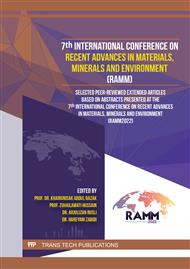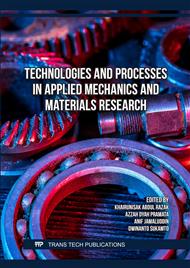[1]
Flörke OW, Graetsch HA, Brunk F, Benda L, Paschen S, Bergna HE, et al. Silica. Ullmann's Encyclopedia of Industrial Chemistry. 2000.
DOI: 10.1002/14356007.a23_583
Google Scholar
[2]
Wills BA, Finch J. Wills' mineral processing technology: an introduction to the practical aspects of ore treatment and mineral recovery: Butterworth-Heinemann; 2015.
DOI: 10.2138/am.2008.502
Google Scholar
[3]
Duvuna G, Ayuba A. A study on silica sand quality in Yazaram and Mugulbu deposits for glass making. Nigerian Journal of Technology. 2015;34(1):109-12.
DOI: 10.4314/njt.v34i1.13
Google Scholar
[4]
Mackay I, Schnellmann. Final Report of Mineral Processing Consultancy Silica Sand. Kuala Lumpur: International Mining Consultants Limited; 2000.
Google Scholar
[5]
Meechoowas E, Suriyoporn S, Yoocharoenkit C, Pleakbaow S. The comparison of different sand sources for glass industrial production. Materials Today: Proceedings. 2021;47:3445-8.
DOI: 10.1016/j.matpr.2021.03.381
Google Scholar
[6]
Ali A. The silica-based industry in Malaysia. Bulletin of the Geological Society of Malaysia. 2003;46:223-30.
Google Scholar
[7]
Abdullah A, Sulaiman S, Baharudin B, Ariffin MKA, Vijayaram T, Sayuti M, editors. Testing for green compression strength and permeability properties on the tailing sand samples gathered from Ex Tin Mines in Perak State, Malaysia. Advanced Materials Research; 2012: Trans Tech Publ.
DOI: 10.4028/scientific5/amr.445.859
Google Scholar
[8]
Tse P-K. The Mineral Industry of Malaysia. Minerals Yearbook-Area Reports: International Review: 2011, V 3, Asia and Pacific. 2013;3:10.
Google Scholar
[9]
Platias S, Vatalis K, Charalampides G. Suitability of quartz sands for different industrial applications. Procedia Economics and Finance. 2014;14:491-8.
DOI: 10.1016/s2212-5671(14)00738-2
Google Scholar
[10]
Ibrahim AF, Seifelnassr AA, Al-Abady A, El-Salmawy MS, Abdelaal AM. Characterization and Iron Removal Enhancement of El-Zaafarana White Sand. Mining, Metallurgy & Exploration. 2022;39(5):2187-98.
DOI: 10.1007/s42461-022-00667-0
Google Scholar
[11]
Ibrahim SS, Selim AQ, Hagrass AA. Gravity separation of silica sands for value addition. Particulate Science and Technology. 2013;31(6):590-5.
DOI: 10.1080/02726351.2013.800930
Google Scholar
[12]
Kapur P, Meloy T. Spirals observed. International Journal of Mineral Processing. 1998;53(1-2):15-28.
DOI: 10.1016/s0301-7516(97)00053-7
Google Scholar
[13]
Zhong T, Yu W, Shen C, Wu X. Research on preparation and characterisation of high-purity silica sands by purification of quartz vein ore from dabie mountain. Silicon2022. pp.4723-9.
DOI: 10.1007/s12633-021-01217-x
Google Scholar
[14]
Ye G, Huo Y, Li C, Deng C, Yu Y, Huang G, et al. A comparative study of trough profile and operating parameters performance in spiral concentrator. International Journal of Coal Preparation and Utilization. 2018.
DOI: 10.1080/19392699.2018.1512493
Google Scholar
[15]
Dixit P, Tiwari R, Mukherjee AK, Banerjee PK. Application of response surface methodology for modeling and optimization of spiral separator for processing of iron ore slime. Powder Technology. 2015;275:105-12.
DOI: 10.1016/j.powtec.2015.01.068
Google Scholar
[16]
Gulsoy O, Kademli M. Effects of operational parameters of spiral concentrator on mica–feldspar separation. Mineral Processing and Extractive Metallurgy. 2006;115(2):80-4.
DOI: 10.1179/174328506x99907
Google Scholar
[17]
Hearn S, Sadowski J. Advances in the Application of Spiral Concentrators for Production of Glass Sand. Advances in Gravity Concentration2003. p.179.
Google Scholar
[18]
Tripathy SK, Murthy YR. Modeling and optimization of spiral concentrator for separation of ultrafine chromite. Powder Technology. 2012;221:387-94.
DOI: 10.1016/j.powtec.2012.01.035
Google Scholar
[19]
Bhattacharya S, Das S. Beneficiation of Glass Sand—A Review. Transactions of the Indian Ceramic Society. 1994;53(2):25-32.
DOI: 10.1080/0371750x.1994.10804626
Google Scholar
[20]
H. Haghi MN, A. Ghorbani editor Reduction of Iron Content from Silica Sand by Scrubbing Process. Proceedings of the 11th International Mineral Processing Symposium 2008; Belek-Antalya, Turkey: Turkish Mining Development Foundation.
Google Scholar



